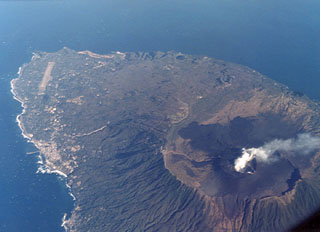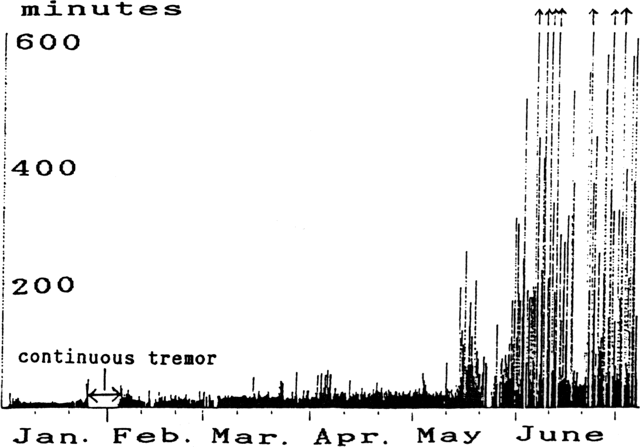Report on Izu-Oshima (Japan) — June 1987
Scientific Event Alert Network Bulletin, vol. 12, no. 6 (June 1987)
Managing Editor: Lindsay McClelland.
Izu-Oshima (Japan) Three earthquake swarms; intermittent tremor continues
Please cite this report as:
Global Volcanism Program, 1987. Report on Izu-Oshima (Japan) (McClelland, L., ed.). Scientific Event Alert Network Bulletin, 12:6. Smithsonian Institution. https://doi.org/10.5479/si.GVP.SEAN198706-284010
Izu-Oshima
Japan
34.724°N, 139.394°E; summit elev. 746 m
All times are local (unless otherwise noted)
Three earthquake swarms occurred in May. The first, 15 km NW of the island, lasted from 6 to about 20 May. It was followed by two weaker swarms; in the SE part of the volcano 22-26 May, and near the summit from 22 May to mid-June (figure 7). About 89 shocks were recorded at the Oshima weather station during the 6-20 May swarm (figure 8), the largest a M 5.1 event at 0635 on 11 May. Swarms have occurred in that area one or two times a year since 1978, most recently in October 1986.
The 22-26 May swarm was the first increase in seismicity in the SE part of the island since the eruption. The largest event, at 0626 on 23 May, had a magnitude of 3.0 and was felt at the weather station. Seismicity in the SE part of the island had decreased steadily and exponentially since the 1986 eruption (figure 9).
 |
Figure 9. Daily seismicity in SE part of Oshima Island, 10 December 1986 to 10 June 1987. Courtesy of JMA. |
An increase in summit-area microearthquakes also began on 22 May. Recorded events increased from about 20/day February-May, to ~40/day after 22 May, and to 100 daily after 29 May; the number of events decreased in mid-June. Steady microearthquake activity had continued near the summit since February, when observation by seismograph began in the area (figure 10). Tremor that began 1 January was intermittently recorded throughout May and June. Tremor episodes generally occurred at regular intervals of 1-2 hours and lasted for about 30 minutes. Beginning 14 May their regularity decreased, intervals between episodes grew from several hours to 20 hours, and episode durations increased to 60-300 minutes (figure 11). The regular tremor interval resumed on 7 June but toward the end of June became irregular again. Long-duration tremor episodes of more than 10 hours were often recorded. Weak steam emission continued at the summit of Miharayama, the central cone, producing about 50-m plumes. Steam rose steadily 0-5 m from craters that had formed on the N-flank fissure in the 1986 eruption.
 |
Figure 10. Daily seismicity in the summit area of Oshima, 20 February-10 June 1987. Courtesy of JMA. |
Geological Summary. Izu-Oshima volcano in Sagami Bay, east of the Izu Peninsula, is the northernmost of the Izu Islands. The broad, low stratovolcano forms an 11 x 13 km island constructed over the remnants of three older dissected stratovolcanoes. It is capped by a 4-km-wide caldera with a central cone, Miharayama, that has been the site of numerous recorded eruptions datining back to the 7th century CE. More than 40 cones are located within the caldera and along two parallel rift zones trending NNW-SSE. Although it is a dominantly basaltic volcano, strong explosive activity has occurred at intervals of 100-150 years throughout the past few thousand years. A major eruption in 1986 produced spectacular lava fountains up to 1,600 m high and a 16-km-high eruption column; more than 12,000 people were evacuated from the island.
Information Contacts: JMA.




